 Southeast Minnesota is a health care and agricultural powerhouse. The region is home to the renowned Mayo Clinic and some of the world's most recognized food companies and brands.
Southeast Minnesota is a health care and agricultural powerhouse. The region is home to the renowned Mayo Clinic and some of the world's most recognized food companies and brands.
Advanced manufacturing is especially strong here, with machinery, chemicals, and electronics among the top products.
Want the freshest data delivered by email? Subscribe to our regional newsletters.
6/22/2017 9:47:04 AM
A snapshot of employment data in the 11 industry supersectors gives a clearer picture of Southeast Minnesota’s economy. The Southeast region has always been a manufacturing powerhouse, but this industry is not at the top of the list in regard to the number of jobs in the region. Manufacturing comes in third behind trade, transportation and utilities, making up 18 percent of the 240,681 jobs in the region, and education and health services, which tops the list at 34 percent of jobs (Figure 1). Altogether, these three supersectors – manufacturing, trade, transportation and utilities, and education and health services – account for over two-thirds (68 percent) of all the jobs in the region. In comparison, they provide just 55.5 percent of total jobs statewide.
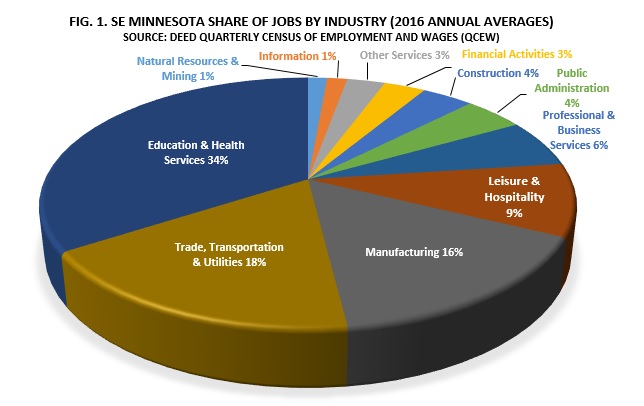
Since 2010 all industries but financial activities have seen an increase in the number of jobs in the Southeast. The largest increases occurred in education and health services, manufacturing, and trade, transportation and utilities – the three industries which already have the highest number of jobs. Identical to their employment share, these three supersectors accounted for 68 percent of the region’s total job growth from 2010-2016 (Figure 2). Statewide, they provided just over 51 percent of total job gains since 2010, making the region’s concentration even more impressive.
Adding 6,165 net new jobs, education and health services saw the highest gain over this time period, buoyed by the Mayo Health System, as well as other health care and social assistance providers. Additionally, manufacturers showed their power by adding 2,515 jobs since 2010, a strong 7 percent increase. On a related note, with the increase in manufacturing jobs, it is reasonable to surmise that a subsequent increase in the production of goods occurred – goods needing transport to other areas of the state and country. This in part explains the more than 1,900 new jobs in trade, transportation, and utilities, along with the continued need for truck drivers and retail salespeople.
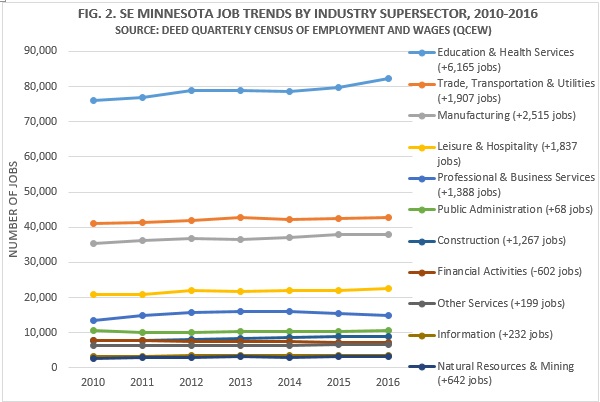
Currently, the three top supersectors reported well over half (56%) of the current vacancies, including over 2,300 postings in health care and social assistance and just over 1,000 openings in retail trade. However, the characteristics of these vacancies were very different, with nearly 90 percent of the postings in retail trade being part-time, compared to just 2 percent of the openings in manufacturing. Wage offers were also much higher in utilities, transportation and warehousing, health care and social assistance, manufacturing, and educational services, according to DEED’s Job Vacancy Survey (Table 1).
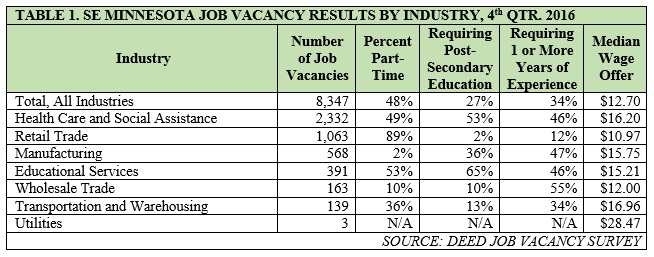
According to DEED’s Employment Outlook data, it doesn’t appear that this trend of greater employment in these three supersectors is going to stop. The region is projected to gain 12,168 net new jobs in the next decade, with the top three supersectors accounting for 74 percent of that growth. Education and health services alone is expected to add over 9,125 jobs, a 14.2 percent growth rate, making it the fastest and largest growing sector. Trade, transportation, and utilities may add about 1,150 jobs, a much more stable 2.7 percent growth rate. Manufacturing is projected to lose about 1,300 jobs through 2024, a rare setback for the big three (Table 2).
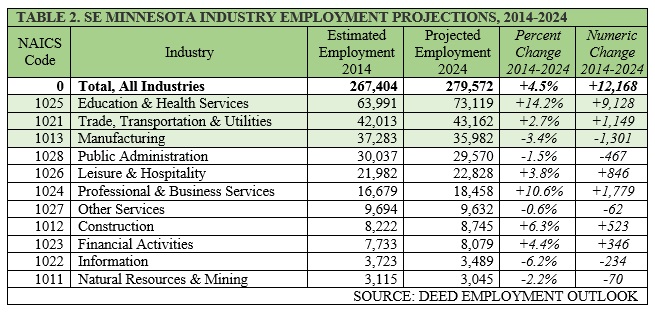
For the most part there is consistency in the percentage of jobs across the 11 supersector industries in each of the counties in the Southeast region, with the top three employing industries most often being in manufacturing, trade, transportation and utilities, and educational and health services. A few counties stray from this pattern, including a much lower percentage of manufacturing employment in Fillmore, Houston, and especially Olmsted County. However, there is a much higher percentage of jobs in education and health services in Olmsted County, likely due to the presence of the Mayo Health System (Table 3).
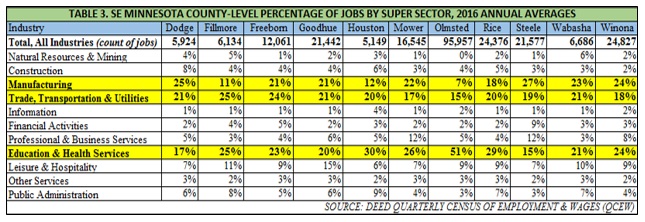
This information benefits job seekers for two reasons. First, it shows which industries may be more challenging to find work in, such as natural resources and mining and information, each accounting for only one percent of the total jobs. This is not to infer that residents should not pursue employment in these fields; rather this information provides a realistic outlook into the possible difficulty of finding employment in these types of jobs. For those who are passionate about working in these more challenging industries, the county-level data shows higher percentages of jobs in certain counties. For example, there are a larger percentage of jobs in natural resources and mining in Dodge, Fillmore and Wabasha counties, as well as a higher percentage of jobs in information in Houston, Olmsted and Winona counties.
Second, for job seekers who desire to work in the industries with the highest percentage of jobs in the region, there are some counties in which they might have more or less luck obtaining employment. For example, a job seeker might have a better chance of obtaining work in manufacturing in Steele County (27 percent of jobs are in manufacturing), but not as much luck in Olmsted County (7 percent in manufacturing). Conversely, over 50 percent of education and health care services jobs in Olmsted County are in this supersector, compared to only about 16 percent in Steele County.
Contact Mark Schultz.